Difference between revisions of "Protege4GettingStarted"
From Protege Wiki
Nickdrummond (talk | contribs) (Initial Page) |
Nickdrummond (talk | contribs) |
||
| Line 18: | Line 18: | ||
Download Protégé 4.0 from http://protege.stanford.edu/download/prerelease-alpha/index.html - please | Download Protégé 4.0 from http://protege.stanford.edu/download/prerelease-alpha/index.html - please | ||
[http://protege.stanford.edu/download/register.html register first] if you've not already done so. This will help us keep track of the number of users. <br /> | [http://protege.stanford.edu/download/register.html register first] if you've not already done so. This will help us keep track of the number of users. <br /> | ||
| − | [[Image: | + | [[Image:download.png]]<br /> |
</li> | </li> | ||
<li><a name="install" id="install"></a>Run the installer.<br /> | <li><a name="install" id="install"></a>Run the installer.<br /> | ||
<br /> | <br /> | ||
| − | [[Image: | + | [[Image:install.png]]<br /> |
<br /> | <br /> | ||
</li> | </li> | ||
| Line 28: | Line 28: | ||
<li>You will now be presented with the Welcome Screen from which you can create a new ontology or open an existing ontology from your local machine or from the web. We can start by opening an existing ontology. <span class="sidenote">Once you have opened or saved some ontologies they will be easily available to click on in the "Open Recent" box.</span><br /> | <li>You will now be presented with the Welcome Screen from which you can create a new ontology or open an existing ontology from your local machine or from the web. We can start by opening an existing ontology. <span class="sidenote">Once you have opened or saved some ontologies they will be easily available to click on in the "Open Recent" box.</span><br /> | ||
<br /> | <br /> | ||
| − | [[Image: | + | [[Image:welcome.png]]<br /> |
</li> | </li> | ||
<li>Download the pizza ontology from http://www.co-ode.org/ontologies/pizza - the unclassified version in RDF syntax will work as an example.</li> | <li>Download the pizza ontology from http://www.co-ode.org/ontologies/pizza - the unclassified version in RDF syntax will work as an example.</li> | ||
| Line 34: | Line 34: | ||
<li>You will now be presented with the main Protégé workspace, starting by default on the <span class="feature">ontologies tab</span>. This tab shows an overview of the pizza ontology, including metrics on its contents, annotations about the ontology as a whole, and other imported ontologies (if there are any). The dropdown on the toolbar displays the currently active ontology - that is the one into which all edits take place. When working on a single ontology this is not a concern. To find something interesting now switch to the <span class="feature">Entities Tab</span> <br /> | <li>You will now be presented with the main Protégé workspace, starting by default on the <span class="feature">ontologies tab</span>. This tab shows an overview of the pizza ontology, including metrics on its contents, annotations about the ontology as a whole, and other imported ontologies (if there are any). The dropdown on the toolbar displays the currently active ontology - that is the one into which all edits take place. When working on a single ontology this is not a concern. To find something interesting now switch to the <span class="feature">Entities Tab</span> <br /> | ||
<br /> | <br /> | ||
| − | [[Image: | + | [[Image:tab-ontologies.png]]<br /> |
<br /> | <br /> | ||
</li> | </li> | ||
<li>The entities tab is the workhorse of the ontology editor. From here you can explore all of the classes, properties and individuals in an ontology. As you may have already noticed each <span class="feature">tab</span> is made up of several <span class="feature">views</span> which can be resized, removed, floated, split and layered - more about views later. The selection model is global, so when a class, property or individual is selected in the trees on the left hand side, the right pane changes to display the selection immediately. In addition most views implement <span class="feature">hypertext navigation</span> so that links can be followed easily regardless of which view the user is in. Opening up the hierarchies and selecting a class or property displays the appropriate description on the right. Backward and forward navigation is possible with the left and right arrow buttons in the toolbar, which act just like a web browser. <br /> | <li>The entities tab is the workhorse of the ontology editor. From here you can explore all of the classes, properties and individuals in an ontology. As you may have already noticed each <span class="feature">tab</span> is made up of several <span class="feature">views</span> which can be resized, removed, floated, split and layered - more about views later. The selection model is global, so when a class, property or individual is selected in the trees on the left hand side, the right pane changes to display the selection immediately. In addition most views implement <span class="feature">hypertext navigation</span> so that links can be followed easily regardless of which view the user is in. Opening up the hierarchies and selecting a class or property displays the appropriate description on the right. Backward and forward navigation is possible with the left and right arrow buttons in the toolbar, which act just like a web browser. <br /> | ||
<br /> | <br /> | ||
| − | [[Image: | + | [[Image:tab-entities.png]]<br /> |
<br /> | <br /> | ||
</li> | </li> | ||
| Line 45: | Line 45: | ||
<li>Note that several views are stacked on top of each other. For example,the annotations view has an additional view hidden underneath - the <span class="feature">Usage view</span>. Show this by clicking on the faint tab underneath the view.<br /> | <li>Note that several views are stacked on top of each other. For example,the annotations view has an additional view hidden underneath - the <span class="feature">Usage view</span>. Show this by clicking on the faint tab underneath the view.<br /> | ||
<br /> | <br /> | ||
| − | [[Image: | + | [[Image:usage.png]]<br /> |
<br /> | <br /> | ||
</li> | </li> | ||
<li>Reasoning with your ontology is one of the most common activities and Protégé 4.0 comes with 2 reasoners built in, FaCT++ and Pellet. To <span class="feature">classify your ontology</span>, open the <span class="feature">Reasoner</span> menu and select one of the available reasoners. <span class="feature">FaCT++</span> will automatically classify your ontology. <span class="feature">Pellet</span> requires that you select classify. Once you have done this the class hierarchy on the entites tab changes to show the <span class="feature">inferred class hierarchy</span>. Unsatisfiable classes appear in red under Nothing and everything else appears in the hierarchy under their inferred superclasses. The asserted class hierarchy is still available, stacked under the asserted one. <br /> | <li>Reasoning with your ontology is one of the most common activities and Protégé 4.0 comes with 2 reasoners built in, FaCT++ and Pellet. To <span class="feature">classify your ontology</span>, open the <span class="feature">Reasoner</span> menu and select one of the available reasoners. <span class="feature">FaCT++</span> will automatically classify your ontology. <span class="feature">Pellet</span> requires that you select classify. Once you have done this the class hierarchy on the entites tab changes to show the <span class="feature">inferred class hierarchy</span>. Unsatisfiable classes appear in red under Nothing and everything else appears in the hierarchy under their inferred superclasses. The asserted class hierarchy is still available, stacked under the asserted one. <br /> | ||
<br /> | <br /> | ||
| − | [[Image: | + | [[Image:inferred.png]]<br /> |
<br /> | <br /> | ||
</li> | </li> | ||
| Line 65: | Line 65: | ||
<li>When happy with the position, click the left mouse button to drop the view (if you want to cancel this operation just click somewhere on the toolbar instead).<br /> | <li>When happy with the position, click the left mouse button to drop the view (if you want to cancel this operation just click somewhere on the toolbar instead).<br /> | ||
<br /> | <br /> | ||
| − | [[Image: | + | [[Image:existentialtree.png]]<br /> |
<li>The existential tree view is now visible (the tree follows existential restrictions along the specified properties and is useful for partonomic relations).</li> | <li>The existential tree view is now visible (the tree follows existential restrictions along the specified properties and is useful for partonomic relations).</li> | ||
</ol> | </ol> | ||
Revision as of 09:50, October 4, 2007
Protégé 4.0: Getting Started
- Download
- Install
- Run
- Navigation
- Reasoning
- Reconfigure the interface
-
Download Protégé 4.0 from http://protege.stanford.edu/download/prerelease-alpha/index.html - please
register first if you've not already done so. This will help us keep track of the number of users.

- <a name="install" id="install"></a>Run the installer.

- Run Protégé from wherever you have installed shortcuts or from the Protégé installation directory specified during installation. On windows, . On a mac there will be a Protege.app, or you can run from one of the scripts. By default, Protégé 4.0 is installed to run in a fairly small memory footprint ~200MB. To get optimum performance you can change this using the instructions here.
- You will now be presented with the Welcome Screen from which you can create a new ontology or open an existing ontology from your local machine or from the web. We can start by opening an existing ontology. Once you have opened or saved some ontologies they will be easily available to click on in the "Open Recent" box.

- Download the pizza ontology from http://www.co-ode.org/ontologies/pizza - the unclassified version in RDF syntax will work as an example.
- Select Open OWL ontology from the welcome screen and find the pizza.owl file on your filesystem.
- You will now be presented with the main Protégé workspace, starting by default on the ontologies tab. This tab shows an overview of the pizza ontology, including metrics on its contents, annotations about the ontology as a whole, and other imported ontologies (if there are any). The dropdown on the toolbar displays the currently active ontology - that is the one into which all edits take place. When working on a single ontology this is not a concern. To find something interesting now switch to the Entities Tab
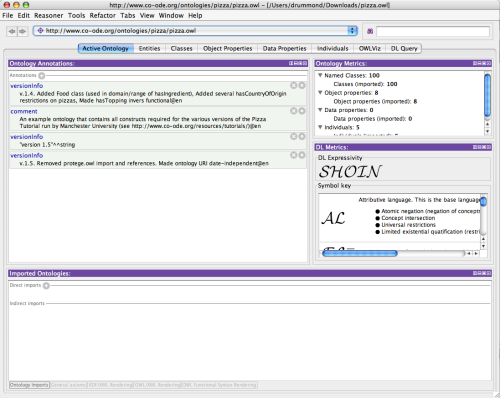
- The entities tab is the workhorse of the ontology editor. From here you can explore all of the classes, properties and individuals in an ontology. As you may have already noticed each tab is made up of several views which can be resized, removed, floated, split and layered - more about views later. The selection model is global, so when a class, property or individual is selected in the trees on the left hand side, the right pane changes to display the selection immediately. In addition most views implement hypertext navigation so that links can be followed easily regardless of which view the user is in. Opening up the hierarchies and selecting a class or property displays the appropriate description on the right. Backward and forward navigation is possible with the left and right arrow buttons in the toolbar, which act just like a web browser.
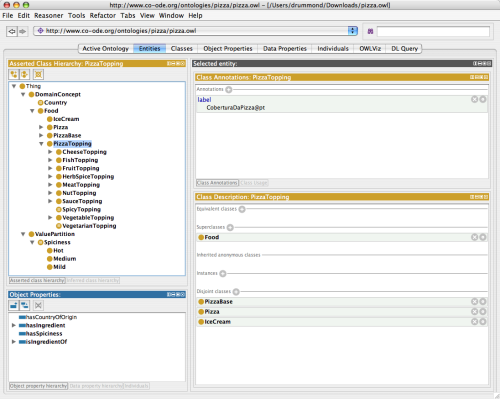
- Another easy way to navigate around the contents of the ontology is to perform a search. The find box in the toolbar performs a global search over any named entity in the ontology. In addition, the hierarchy views have their own find dialogs (first click anywhere in the view to give it focus, then Ctrl-F on windows, Command-F on mac).
- Note that several views are stacked on top of each other. For example,the annotations view has an additional view hidden underneath - the Usage view. Show this by clicking on the faint tab underneath the view.
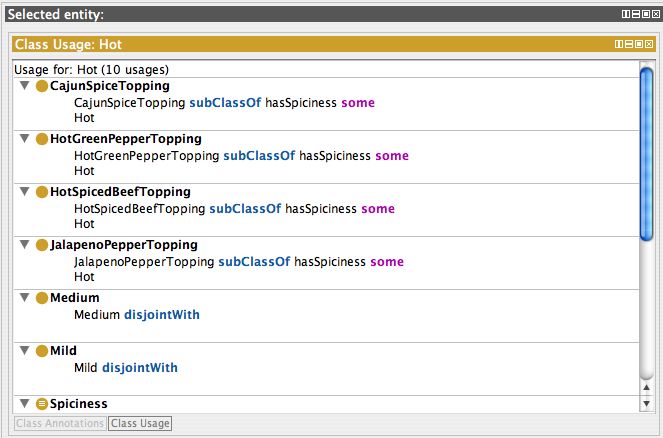
- Reasoning with your ontology is one of the most common activities and Protégé 4.0 comes with 2 reasoners built in, FaCT++ and Pellet. To classify your ontology, open the Reasoner menu and select one of the available reasoners. FaCT++ will automatically classify your ontology. Pellet requires that you select classify. Once you have done this the class hierarchy on the entites tab changes to show the inferred class hierarchy. Unsatisfiable classes appear in red under Nothing and everything else appears in the hierarchy under their inferred superclasses. The asserted class hierarchy is still available, stacked under the asserted one.
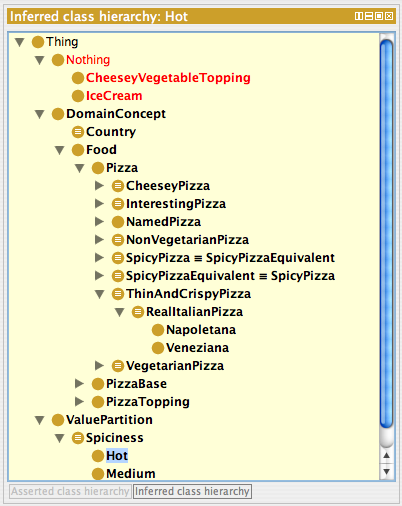
- Investigate the other tabs:
- OWLViz - requires installation of Graphviz before anything will be visible. Shows a graphical representation of the class subsumption hierarchy. A full description of OWLViz is in the OWLViz manual.
- DL Query - requires the ontology has been classified before it will return results. An arbitrary class description can be entered and the reasoner is queried for the sub/super classes, infered members etc depending on what is selected.
- Reconfiguring the interface is easy. Adding and removing tabs and views is possible through the tabs and view menus. Try removing the Classes, and Properties views to declutter the screen. Try adding a view to the Entities tab:
- Select a class to make sure the Selected Entity view is showing class views.
- Select View->Class Views->Existential Tree - now when you float over the editor a blue outline shows where the new view will be dropped - either on top of, above, below, left or right of each of the current views.
- When happy with the position, click the left mouse button to drop the view (if you want to cancel this operation just click somewhere on the toolbar instead).
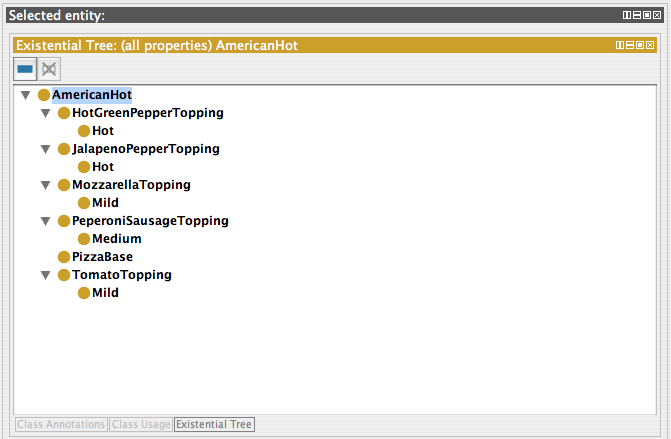
- The existential tree view is now visible (the tree follows existential restrictions along the specified properties and is useful for partonomic relations).
All changes will be saved when Protégé is shut down properly (or this can also be forced by selecting Save Current Layout in the Tabs menu).